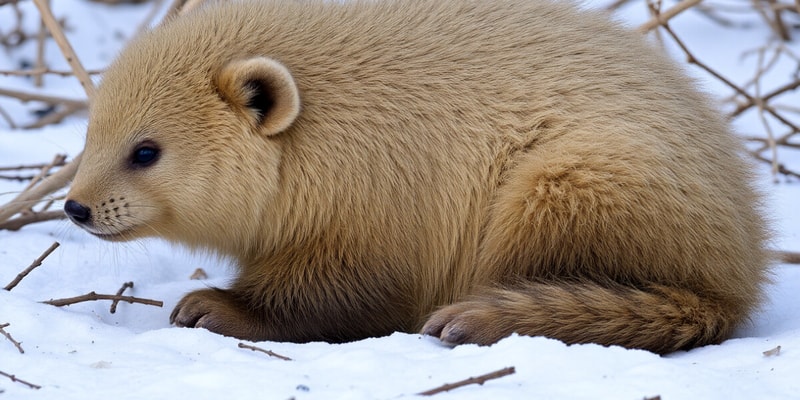Podcast Beta
Questions and Answers
What adaptation do frozen frogs utilize to prevent cell damage during freezing?
What is the primary difference between true hibernators and bears during their hibernation period?
Which of the following statements about torpor is accurate?
How do Antarctic fish and crustaceans adapt to extremely low temperatures?
Signup and view all the answers
What behavioral adaptation do animals employ to cope with temperature variations?
Signup and view all the answers
During hibernation, what critical process allows bears to recycle urea?
Signup and view all the answers
What is the primary purpose of behavioral thermoregulation in animals?
Signup and view all the answers
Which of the following adaptations is used by animals to tolerate periods of dormancy?
Signup and view all the answers
What defines an endotherm?
Signup and view all the answers
How does ectothermy affect an organism's metabolic activity?
Signup and view all the answers
Which group of animals is classified as ectotherms?
Signup and view all the answers
Which term describes the variation in body temperature in ectotherms?
Signup and view all the answers
What is a primary advantage of endothermy?
Signup and view all the answers
What is a defining feature of heterothermy?
Signup and view all the answers
What temperature range do lizards and snakes typically experience in a day?
Signup and view all the answers
How do ectotherms primarily regulate their body temperature?
Signup and view all the answers
What is a significant trade-off for ectotherms?
Signup and view all the answers
What adaptation helps endotherms to maintain their body temperature in changing seasons?
Signup and view all the answers
Which body shape promotes a low surface-to-volume ratio in large animals?
Signup and view all the answers
What is a physiological adaptation of endotherms for thermoregulation?
Signup and view all the answers
How does the body size of an animal affect heat exchange?
Signup and view all the answers
Which morphological adaptation can help endotherms dissipate heat?
Signup and view all the answers
What is NOT a cost for ectotherms in terms of body temperature regulation?
Signup and view all the answers
What is a benefit of having a small, flattened body for an ectotherm?
Signup and view all the answers
Study Notes
Temperature Fluctuations
- Temperature fluctuations can occur at different scales: latitudinal, daily, and seasonal.
- Some animals, like frozen frogs, have adapted to survive extremely low temperatures.
- Frozen frogs use ice-nucleating proteins outside of their cells to control ice formation, and they produce solutes like glucose and glycerol inside their cells to lower the freezing point.
- This adaptation ensures that freezing water is primarily limited to spaces outside the cells, preventing further freezing.
Dormancy States
- Hibernating mammals experience a significant drop in body temperature, often below 10 degrees Celsius.
- While hibernating, the body temperature of some animals, like the European ground squirrel, isn't constant.
- Bears don't truly hibernate; their body temperature drops only slightly.
- Bears are easily awakened and don't eat, drink, urinate, or defecate during this period.
- They can give birth and nurse their young while sleeping, further indicating their inactive state.
- Torpor is a state of lowered body temperature for part of each day, often seen in animals like hummingbirds, who enter this state at night.
Tolerating and Modifying Temperature
- To handle varying temperatures, animals can tolerate them through special enzymes or modify their behavior, physiology, or morphology.
- Some animals, like Antarctic fish and crustaceans, have enzymes that function effectively even at -2 degrees Celsius.
Behavioral Solutions
- Seasonal migration is a common behavioral adaptation for handling temperature variations. For example, the monarch butterfly migrates long distances to escape harsh winters.
- Behavioral thermoregulation involves seeking out sunny or shady spots, shelters, or using water to cool down.
- Lizards and snakes are good examples of animals that regulate body temperature using behavioral mechanisms, with their body temperature fluctuating only slightly throughout the day.
Endothermy vs. Ectothermy
- Endotherms generate their own internal heat ("warm-blooded") and maintain a relatively constant internal temperature ("homeothermy"). Examples include birds and mammals.
- Ectotherms gain heat from the environment ("cold-blooded") and have variable body temperatures ("poikilothermy"). Examples include most fish, amphibians, reptiles, and invertebrates.
- Some animals exhibit both endothermic and ectothermic traits ("heterothermy"), such as bats, bees, hummingbirds, and hibernating animals.
Endothermy and Ectothermy
- Endotherms use energy from respiration to maintain their body temperature, enabling them to maintain consistent enzyme function across a wider range of environmental temperatures.
- Ectotherms rely on external heat sources, leading to an increase in metabolic rate when the temperature rises. They are primarily active when warm enough.
Trade-offs Between Endothermy and Ectothermy
- Endotherms can be active in various temperatures but need more calories, limiting their energy for growth and reproduction.
- Ectotherms require fewer calories, allowing them to thrive in low-productivity environments like deserts. However, their body temperature isn't always optimal, and they rely on behavioral thermoregulation.
Adaptations of Endotherms
- Endotherms have evolved diverse adaptations for temperature regulation, including insulation (fat, fur, feathers), which can change thickness seasonally.
- Insulation can also serve to prevent heat loss, as seen in camels, whose fur dissipates absorbed heat.
- Brown fat is metabolized for heat generation, particularly important in hibernating animals.
Temperature and Body Size
- Animals with large, rounded bodies have a lower surface area to volume ratio, leading to slower heat exchange.
- Small, flattened bodies have a higher surface area to volume ratio, resulting in rapid heat exchange.
- Body size significantly influences how animals manage heat, with larger animals generally losing heat more slowly than smaller animals.
Studying That Suits You
Use AI to generate personalized quizzes and flashcards to suit your learning preferences.
Related Documents
Description
Explore how temperature fluctuations impact animal adaptations and dormancy states. Learn about unique survival strategies of animals like frozen frogs and hibernating mammals, including their physiological changes during these periods. Understand the differences between true hibernation and other states of dormancy.




